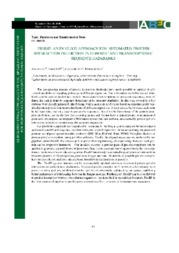PredIP: an in silico approach for automated protein interaction prediction in genomic and transcriptomic sequence databanks.
PredIP: an in silico approach for automated protein interaction prediction in genomic and transcriptomic sequence databanks.
Autoria: ALVAREZ, J. C.; HERAI, R. H.; CARAZZOLLE, M. F.; PEREIRA, G. G. A.
Resumo: The fast-growing amount of protein interaction databanks have made possible to analyze deeply several metabolic or signaling pathways in different organisms. The information available in such databanks can be used to predict new protein interactions in transcriptome or proteome sequences, most of times this task is done by sequence homology or by structure similarity. In this way, several in silico systems were already proposed, like Peimap, which makes its predictions based on experimentally validated protein-protein interaction databanks of different organisms. A restricting criteria to use such tools is the input data, that only accepts proteomic sequences. Based on the importance of the protein complex prediction, and in the fact that several genomes still do not have a transcriptome or an annotated proteome, we propose an integrative Web-based system that can perform, automatically, protein-protein interaction predictions considering also genomic sequences. Our prediction approach was organized in two steps. In the first, a system analyses the input dataset and uses FrameDP and Augustus, two free softwares, to predict proteins. In the second step, the predicted proteins are aligned against avaiable databases (DIP, Mint, BioGrid, Bind, HPRD, StringInts, IntAct) of protein-protein interactions using psi-blast software. Finally, the aligned sequences are analyzed by our pipeline, called PredIP, that creates an interactive chart representing all relationships between each protein and its respective interactor. Our in silico strategy to predict pairs of protein complexes can be applied in genomic, transcriptomic or proteomic data, is not necessary knowing previously the transcriptome or proteome of a considered organism. PredIP has already been tested to predict protein interactions between proteins of Moliniopthora perniciosa fungus genome. Hundreds of possible protein complex have been predicted, and have already been described in the literature as possible. The PredIP system structure can be incrementally updated with new discovered protein-protein interactions to perform new predictions. Predicted protein complex in M. perniciosa has already been proved to exist, and new predicted complex will be experimentally validated by our group, enabling a better understands of relationship between the fungus proteins. Furthermore, PredIP can be a useful tool to predict interactions between two distinct organisms. As described in specialized literature, PredIP is the first automated pipeline to predict protein complexes from genomic or transcriptomic sequences.
Ano de publicação: 2010
Tipo de publicação: Resumo em anais e proceedings
Unidade: Embrapa Agricultura Digital
Palavras-chave: Bases de dados, Interação entre proteínas, Proteínas
Observações
1 - Por padrão são exibidas publicações dos últimos 20 anos. Para encontrar publicações mais antigas, configure o filtro ano de publicação, colocando o ano a partir do qual você deseja encontrar publicações. O filtro está na coluna da esquerda na busca acima.
2 - Para ler algumas publicações da Embrapa (apenas as que estão em formato ePub), é necessário ter, no celular ou computador, um desses softwares gratuitos. Sistemas Android: Google Play Livros; IOS: iBooks; Windows e Linux: software Calibre.
Acesse outras publicações
Acesse a Base de Dados da Pesquisa Agropecuária (BDPA) para consultar o acervo completo das bibliotecas da Embrapa.

